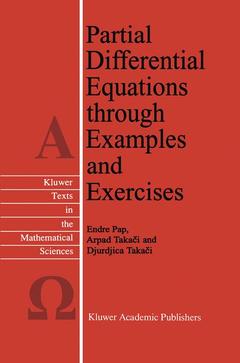Partial Differential Equations through Examples and Exercises, 1997 Texts in the Mathematical Sciences Series, Vol. 18
Langue : Anglais
Auteurs : Pap E., Takaci Arpad, Takaci Djurdjica

The book Partial Differential Equations through Examples and Exercises has evolved from the lectures and exercises that the authors have given for more than fifteen years, mostly for mathematics, computer science, physics and chemistry students. By our best knowledge, the book is a first attempt to present the rather complex subject of partial differential equations (PDEs for short) through active reader-participation. Thus this book is a combination of theory and examples. In the theory of PDEs, on one hand, one has an interplay of several mathematical disciplines, including the theories of analytical functions, harmonic analysis, ODEs, topology and last, but not least, functional analysis, while on the other hand there are various methods, tools and approaches. In view of that, the exposition of new notions and methods in our book is "step by step". A minimal amount of expository theory is included at the beginning of each section Preliminaries with maximum emphasis placed on well selected examples and exercises capturing the essence of the material. Actually, we have divided the problems into two classes termed Examples and Exercises (often containing proofs of the statements from Preliminaries). The examples contain complete solutions, and also serve as a model for solving similar problems, given in the exercises. The readers are left to find the solution in the exercises; the answers, and occasionally, some hints, are still given. The book is implicitly divided in two parts, classical and abstract.
Preface. List of Symbols. 1. Introduction. 2. First Order PDEs. 3. Classification of the Second Order PDEs. 4. Hyperbolic Equations. 5. Elliptic Equations. 6. Parabolic Equations. 7. Numerical Methods. 8. Lebesgue's Integral, Fourier Transform. 9. Generalized Derivative and Sobolev Spaces. 10. Some Elements from Functional Analysis. 11. Functional Analysis Methods in PDEs. 12. Distributions in the Theory of PDEs. Bibliography. Index.
This book examines the complicated subject of Partial Differential Equations (PDEs). It involves the reader throughout by presenting theory, examples and exercises together. Both the classical and abstract aspects of the theory are dealt with, so that, for example, classical and generalised solutions in Sobolev and distribution spaces are treated. Most of the work is devoted to second or higher order PDEs, part of the distribution theory is included, covering Dirac's delta distribution delta function. Many practical tools are offered for solving important problems with the basic three PDEs, namely the wave equation, the Laplace equation, the heat equation and their generalisations. The majority of the problems are mathematical in character, though often phys
Date de parution : 10-2012
Ouvrage de 404 p.
15.5x23.5 cm
© 2024 LAVOISIER S.A.S.



